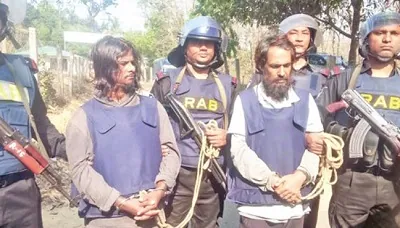
The Rapid Action Battalion (RAB) has recently uncovered a video revealing the sensitive activities of the newly emerged militant group, Jamatul Ansar Fil Hindal Sharqiya (JAFHS), including their training camps located in remote areas of Bandarban and Rangamati.
Let’s delve deeper into this emerging threat to Bangladesh’s security landscape.
Who is who of Jamatul Ansar Fil Hindal Sharqiya
According to law enforcement agencies, the Jamatul Ansar Fil Hindal Sharqiya (JAFHS) began organizing in 2017. The group is made up of former members of three banned militant organizations: Ansar Al Islam, Neo-JMB, and Harkat-ul-Jihad. In 2019, they adopted the name Jamaatul Ansar Fil Hindal Sharqiya.
The leader of the organization (amir) is Anisur Rahman, also known as Mahmud. Abdullah Maimun is the head of the organization’s dawat, or preaching and recruiting section. Masukur Rahman, also known as Ranbir, is the head of the military wing and a member of the group’s Shura, or decision-making body.
On January 23, 2023, Ranbir was arrested in a raid by the Rapid Action Battalion (RAB) in the Kutupalong Rohingya camp in Cox’s Bazar’s Ukhia. His associate, bomb expert Abu Bashar, was also arrested in the same raid.
According to RAB, Ranbir used to work at a post office and led an armed robbery gang before joining the group. He met the leaders and activists of the banned militant group JMB while in prison and decided to join forces with them. He continued to visit JMB members in jail after his release and had contact with their families as well. In 2017, he met Rakib, a Shura member and later head of Jama’atul Ansar Fil Hindal Sharqiya’s finance and media wing, and became a founding member.
Sabbir, also known as Karse, and Didar, also known as Champai, were in charge of the group’s military activities.
So far, 38 members of the militant outfit have been arrested, according to RAB.
Does Jamatul Ansar Fil Hindal Sharqiya have any international links?
According to Shafi Md Mostofa, an associate professor of world religions and culture at the University of Dhaka and an adjunct lecturer at the University of New England, Australia, there are several indications that the Jamaatul Ansar Fil Hindal Sharqiya has ties to al-Qaeda. Its name, which translates to “Jama’atul Ansar in East India,” reflects al-Qaida’s Indian subcontinental agenda. Additionally, one of the seven militants arrested on October 6, 2022, told the media that he was sent videos of Jashimuddin Rahmani, an al-Qaida ideologue who has been in jail since 2016.
However, Bangladeshi authorities have not made any official comment on this issue.
Activities in Bangladesh
Jamatul Ansar Fil Hindal Sharqiya has been conducting training campaigns in the Chittagong Hill Tracts in the camps of another armed ethnic group known as the Kuki-Chin National Front (KNF). The KNF claims to represent six ethnic groups, including the Bom. The training of JAFHS members began at the end of 2021.
In a recent raid on KNF’s camps by Bangladeshi law enforcement agencies, it was revealed that JAFHS had a written agreement with KNF for the training of their members. The duration of the training was set to last until 2023. So far, JAFHS has sent 55 members in three batches for the training.
The military activities or training in the KNF camps were divided into two parts.
JAFHS is also active in the Rohingya camps in Cox’s Bazar. Recently, the Rapid Action Battalion (RAB) conducted a raid in the Kutupalong Rohingya camp area of Ukhiya and arrested the head of the military wing of the new militant organization from there. RAB is currently investigating how the militants came to be in the Rohingya camp and their connections.
Attack plan
Like the Jama’atul Mujahideen Bangladesh (JMB) in 2005 and the Neo-JMB in 2016, the Jamatul Ansar Fil Hindal Sharqiya also had plans to declare its emergence through a large-scale attack. Before that, they were trying to create 313 trained cadres.
They also made a promotional video to circulate on that day, which has been recovered by the Rapid Action Battalion (RAB).
JAFHS also had plans to attack the Kashimpur Central Jail in Gazipur, where many militant leaders are currently interned. According to the militants, these leaders are ‘tortured Muslim prisoners’.







